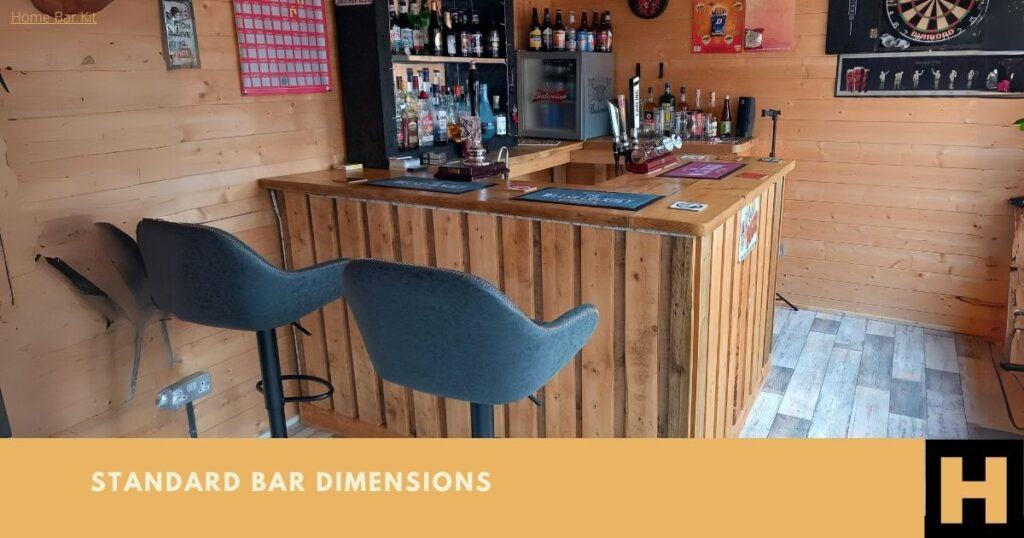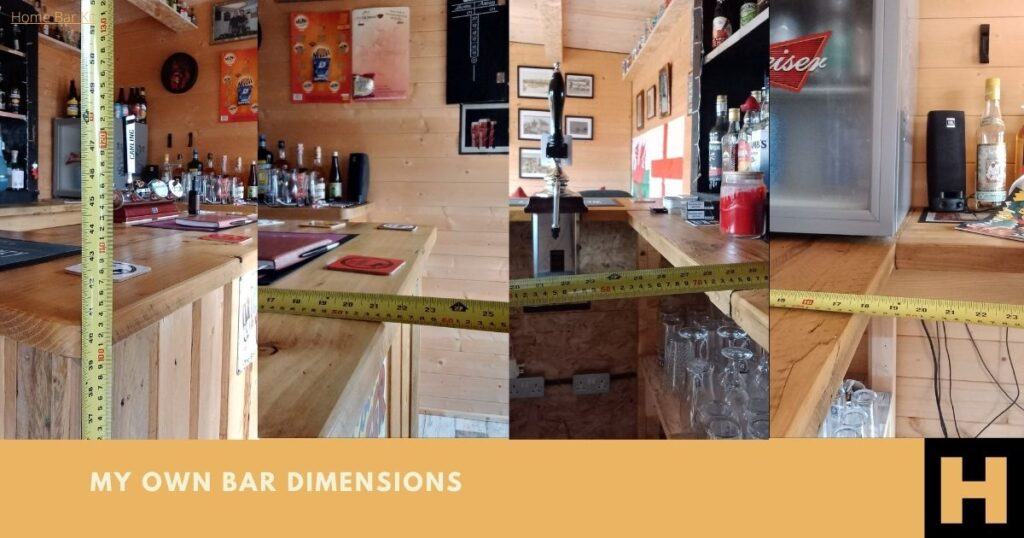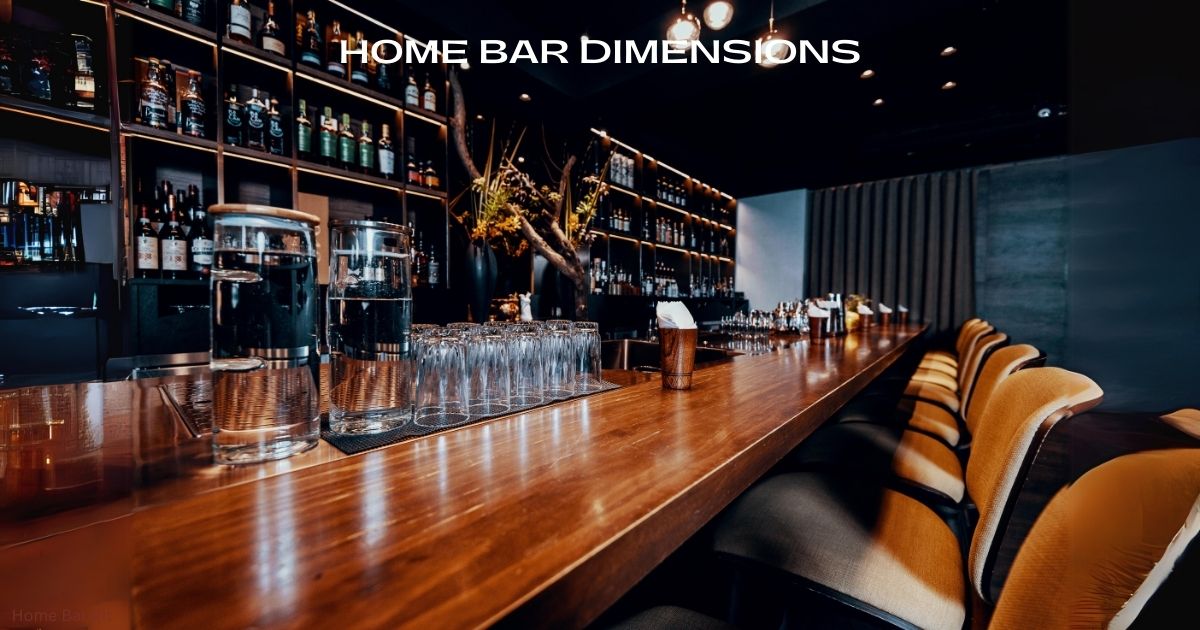Creating a home bar is an exciting project, but it’s not just about picking the right stools and glasses. It’s crucial to start with the right dimensions to ensure your home bar is not only good-looking but also fully functional.
Although a home bar can be built to your own custom measurements, it is a good idea to be guided by the standard measurements. A good guide is: The bar top height should be 42″ – 45″ (106-114cm). The bar top depth should be 24″ – 30″ (61-76cm). And the aisle width behind the bar should be 31″ – 37″ (79-94cm).
These are standard measurements that act as a good guide and make sure your home bar is a nice place to serve drinks from as well as sit at.
Table Of Contents
- The Balance Between Design And Functionality
- What Bar Design Is Best?
- Standard Dimensions for Your Home Bar
- Incorporating Appliances: Focus on the Fridge
- My Own Bar Dimensions
- Final Touches: Bringing Your Home Bar Vision to Life
The Balance Between Design And Functionality

Understanding the balance between design and functionality is vital when building a home bar.
When choosing the bar dimensions take into account the number of people you want to entertain, the kind of drinks you’ll serve, and how you prefer to engage with your guests while playing the perfect host.
The right dimensions can make your home bar a comfy spot for friends and family to gather around.
However if you go too small, you’ll be bumping elbows and forever getting in each others way. But too large, and your cozy get-togethers might lose that intimate vibe.
Think of your home bar as the perfect blend of a personal café and your favourite pub, right in your home.
Obviously there are different bar designs and shapes to consider including straight, L-shaped, and U-shaped options. Each shape has its charm and suits different spaces and styles of entertaining.
What Bar Design Is Best?
Choosing the right design shape for your bar is just as crucial as the specific dimensions. Your home bar should be more than a place to mix drinks; it should reflect your personality and cater to your socializing style.
A straight bar is a straightforward design that maximizes space, as well as be the easiest to build. It’s a versatile design and easy to set up even in limited spaces.
The L-shaped bar, on the other hand, is perfect if you love hosting and want to encourage more engagement among your guests.
However it will take up more room than a straight bar and be more complicated to build.
The U-shaped bar is the ultimate for a grand design. It can be the focal point of your home bar and allow for greater interaction with guests and you.
But it will require the most space, so if space is tight, then a U-shaped bar will be out of the question. Also it is the most complicated bar design of the three, using more materials and more skill to build.
Ultimately your choice in bar shape and dimensions is a personal thing and only governed by the space you have available. It’s about your lifestyle and entertainment preferences.
Standard Dimensions for Your Home Bar

If you want to ensure your home bar feels just as professional as your favourite local bar. Then getting the dimensions right is fairly important.
There is an industry standard that many bars adhere to when they are built. So that is the obvious place to start when building a home bar.
Although a home bar can be built to your own custom measurements, it is a good idea to be guided by the standard measurements.
- The bar top height should be 42″ – 45″ (106-114cm).
- The bar top depth should be 24″ – 30″ (61-76cm).
- The aisle width behind the bar should be 31″ – 37″ (79-94cm).
The standard height is ideal because it works well whether you’re standing or using a bar stool. Shorter or taller individuals can always make adjustments, but keep in mind that varying too far from the standard might affect the ease with which guests can use the bar.
A typical bar top should have enough depth to comfortably place drinks, with enough room for a bartender to mix and serve from the other side.
If it’s too shallow, you risk spills and limited function; too deep, and it might become difficult to reach across.
Bear in mind if you are thinking of a lower bar or under-bar area behind the bar for mixing drinks, you will need to take into account the extra depth. This could entail an additional 18 to 24 inches of depth below the countertop.
The aisle width is important for your comfort and ease of serving drinks an moving around behind the bar.
Too small and it will become an unpleasant place to be, forever banging elbows or having trouble moving around. However if it is too big, then it is just a waste of space that could be utilised the other side of the bar.
Remember to think about storage solutions for your bar essentials, like shelves or cabinets, ensuring glasses and bottles are within reach but not in the way.
Also before you even think about building, consider whether you want to have a back bar too. This is normally an extra counter top or cabinet or shelves running along the back of the bar. It will obviously require extra space, a standard back bar depth is 24″ (61cm) to 29″ (74cm).
And Don’t forget appliances.
Incorporating Appliances: Focus on the Fridge
A fridge is possibly the most important appliance you will have in a home bar. So choosing the perfect fridge for your home bar isn’t just about picking the shiniest model at the store; it’s about considering dimensions and functionality.
If you’re installing a fridge under your bar, measure twice and buy once! You’ll want to leave enough room for the fridge door to swing open without hitting anything. A standard under-counter fridge usually needs at least 24″ (60cm) in width and depth, although compact options are available.
When it comes to ventilation, under-counter appliances need breathing room to avoid overheating. Check the manufacturer’s guidelines for clearance space around the fridge. You might need to adapt your bar dimensions slightly to accommodate this.
Beyond the size and ventilation, think about what you’ll stock in your fridge. If you’re passionate about craft beers, a fridge with adjustable shelving is a smart choice. Planning to showcase vintage wine? Consider a dedicated wine cooler with temperature control settings.
Also, you’ll need an easily accessible power source for you fridge to plug into, another thing to consider at the planning stage.
Besides the fridge, other appliances like ice makers and dishwashers could be part of your plan. Don’t crowd them; they also need their space for efficient operation.
Finally, look at the big picture. It’s not about fitting an appliance into an existing design it’s about creating a design that makes room for all your needs, including the fridge.
That’s going to include thinking about how people will move around the bar, where they’ll sit, and how the bartender interacts with the space and devices.
My Own Bar Dimensions

So did I adhere to the standard dimensions when building my own home bar? I know I used them as a guide, but had to remeasure to remember how close I built mine to the standard.
- The bar top height is 401/2″ (103cm).
- The bar top depth should be 21/12″ (55cm).
- The aisle width behind the bar should be 29″ (74cm).
- The back bar depth is 18″ (46cm).
I have gone slightly less than the lower industry standards and it works fine for me and my guests. The aisle width behind the bar is fine and gives me plenty of room to move around, bend and make drinks.
Final Touches: Bringing Your Home Bar Vision to Life
Don’t worry too much if you’re not 100% sure from the start. You can always make changes and adjustments later on. What’s most important is starting with a solid plan that incorporates the function and form you desire.
You can always adjust your approach down the road, tweaking shelf heights or expanding storage options. But locking in those key dimensions early sets the stage for a well-functioning bar that feels just right from the get-go.
After all, your bar isn’t just about aesthetics – it’s also about creating a social hub that’s geared for gathering, chatting, and enjoying good times.
With thoughtful planning, precise measurements, and a little creativity, you’re going to enjoy a home bar that not only looks incredible but serves its purpose beautifully.
Rob is a passionate home bar and pub shed enthusiast with a passion for craft beer. With hands-on experience in designing and building his own home bar, Rob shares his knowledge, tips, and inspiration to help fellow enthusiasts create their own perfect space. Alongside the world of home bars and pub sheds, Rob also explores the diverse and exciting realm of craft beer, providing honest reviews to help you discover your next favorite brew. Join Rob on a journey of flavor, design, and craftsmanship right here on Home Bar Kit.


How I wish I had run into your article a few months ago. I would have been of much more assistance to my friend, who wanted my suggestions before he built the bar in his house. Looking at the advice in your post and the standard dimensions that you let us in on, I see the reasons why his bar is now rarely used when we do meet up at his house.
My friend hasn’t talked about renovating the bar yet, but when he does, I now have the right information to support him with. Thank you, Rob.
Hi Oluseyi,
I hope your friend does decide to renovate his bar as they really are good entertaining spaces for family and friends. It is okay to go slightly smaller than the standard commercial measurements, just as long as you don’t take too much off.
I am pleased you found the article of use if your friend does to make changes, and if he has any questions then please ask as I will be happy to help.
Thanks
Rob